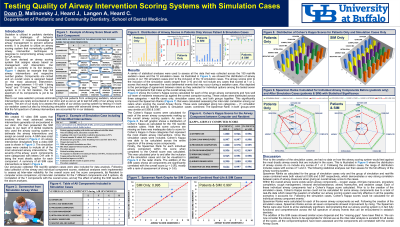Sedation
435 - Testing Quality of Airway Intervention Scoring Systems with Mock Scenarios


Dean N. Doan, DMD (he/him/his)
Resident
University at Buffalo/Women and Children’s Hospital of Buffalo, Buffalo, NY
University at Buffalo
Buffalo, New York, United States- CH
Christopher Heard, MD
University at Buffalo, New York

Christopher Heard, MD
Anesthesiologist
University at Buffalo, New York
Buffalo, New York, United States- TT
Tammy Thompson, DDS
University at Buffalo School of Dental Medicine
Buffalo, New York, United States
Presenting Author(s)
Co-Author(s)
Research Mentor(s)
Program Director(s)
Purpose:
Sedation is often employed in pediatric dentistry due to challenges of behavior management. Sedation requires knowledge of airway management and techniques to prevent adverse events. It is prudent to utilize an airway intervention scoring system that numerically qualifies airway intervention techniques in response to compromising airway events. Our team has devised a scoring system that assigns numerical values to the quality of airway management for each sedation case. This system is currently in its third iteration. The scores range between 1 and 10 with 1 qualifying as a “best case scenario” where no intervention was required and 10 qualifying as “worst case scenario” where the most advanced anesthesia techniques were used for intervention. The purpose of this study is to assess the quality of our airway intervention scoring system. Our case selection does not select for high-risk patients requiring advanced intervention techniques. It is difficult to assess how well this scoring system applies in cases with compromised airways requiring greater intervention. With IRB approval, mock scenarios will be used involving all of the airway intervention techniques including the most advanced. Each case will be assessed by pairs of residents to determine the airway score. The correlation between each participant will indicate how reliable our airway intervention scoring system is when considering the full spectrum of airway intervention techniques. The overall score, plus the score’s components, will be assessed for inter-rater reliability. Including all possible airway interventions should improve the accuracy and validity of the score.
Methods:
Results:
Conclusions:
Identify Supporting Agency and Grant Number:

.jpg)